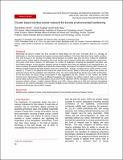| dc.description.abstract | Monitoring the forest’s weather has been essential to living things over the years. Currently, there is a shortage of information on real-time temporal and spatial environmental conditions of the forest that drive forest health condition. This work focuses on the sensing of humidity and temperature as weather data from the forest. Unlike the traditional systems used to collect weather information, the use of wireless sensor network (WSN) gives real-time data capture from every point of the forest. However, the WSN faces, the number of challenges, including low bandwidth, low power, and short battery lifespan. In this situation, batteries cannot be replaced since nodes are deployed in an inaccessible area. In order to prolong the network lifetime and reduce the network delay, we propose Zone based Clustering (ZbC) scheme and efficient routing to find the best path between source and cluster head. Initially, we deploy sensor nodes in three coronas namely C1, C2 and C3. We place the sink node at the center of the coronas. Based on the center point of the corona, we split each corona into four partitions each with three zones. Our work composed of two phases such as ZbC and Routing. In the first phase, we reduce energy consumption in data aggregation via ZbC scheme. In ZbC scheme, the hybrid Particle Swarm Optimization (PSO) and Affinity Propagation (AP) algorithm are utilized. Network delay is reduced in the second phase using Ant Colony Optimization (ACO) and FireFly Algorithm (FFA). Simulation results confirm that our proposed solution achieves a higher network lifetime up to 30%, reduces delay up to 35% and enhances throughput compared to the existing cooperative Time Division Multiple Access (cTDMA), Dynamic Random Allocation (DRA) and improved Artificial bee colony (iABC) methods. | en_US |

